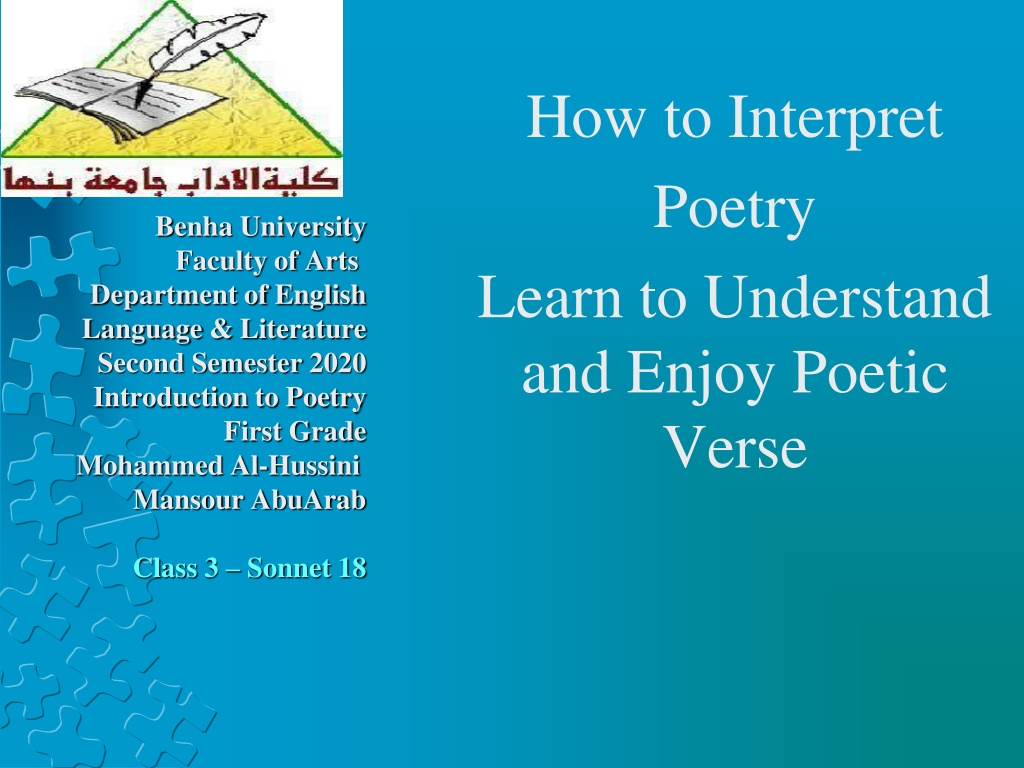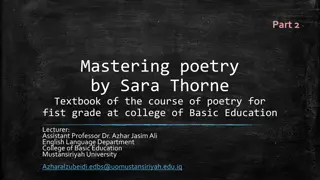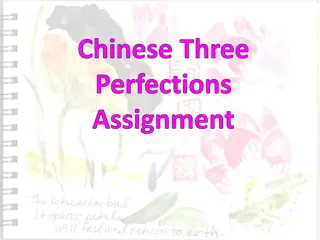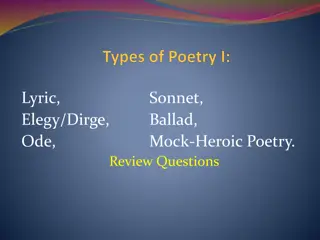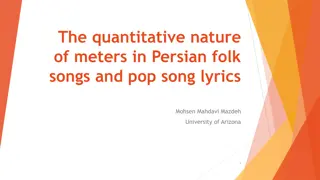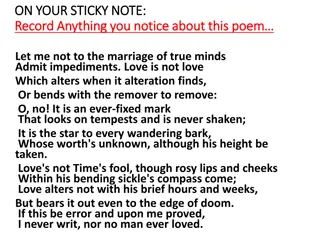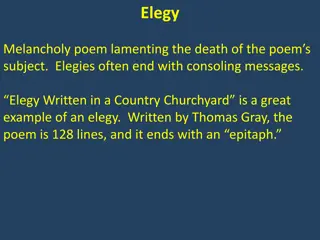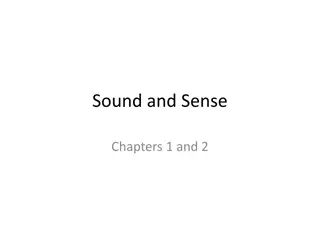Understanding and Enjoying Poetry: Unraveling the Sonnet Form through Petrarch
Delve into the intricacies of interpreting poetry, specifically the sonnet form, focusing on the origins of the Italian sonnet and the influence of poets like Petrarch. Explore the complexities of Petrarch's sonnets in relation to love, inner conflict, and unfulfilled desires, shedding light on the emotional depth and timeless resonance of poetic verse.
Download Presentation

Please find below an Image/Link to download the presentation.
The content on the website is provided AS IS for your information and personal use only. It may not be sold, licensed, or shared on other websites without obtaining consent from the author. Download presentation by click this link. If you encounter any issues during the download, it is possible that the publisher has removed the file from their server.
E N D
Presentation Transcript
How to Interpret Poetry Learn to Understand and Enjoy Poetic Verse Benha University Faculty of Arts Department of English Language & Literature Second Semester 2020 Introduction to Poetry First Grade Mohammed Al-Hussini Mansour AbuArab Class 3 Sonnet 18
The Sonnet
Literary Terms Sonnet fixed verse form of Italian origin consisting of 14 lines that are typically five-foot rhyming according prescribed scheme. its highest expression in the 14th century in the poems of Petrarch first introduced to England by Thomas Wyatt and the Earl of Surrey its major forms: the Petrarchan (or Italian) sonnet, and the iambics to a
Origins of the sonnet Italy, Jacopo da Lentini. Sicilian school, 13th century term derived from the Italian sonetto, little song Dante (1265 1321) Guido Cavalcanti (c. 1250 1300) Petrarch (1304-1374)
Francesco Petrarca (Petrarch) his sonnets are contained in a collection called Canzoniere (Rerum Vulgarium Fragmenta) 366 poems in the Italian vernacular language 14 lines, an octave and a sestet written over a long period of time (1330-1365) arranged as an intimate diary two parts: In vita di Madonna Laura, In morte di Madonna Laura Laura: the woman loved by the poet
unlike the idealised women of the Dolce Stil Novo she doesn t lead to God, but makes the poet deviate the reason for the poet s inner conflict, between the sensual temptation of love and his aspiration to asceticism love for this woman a complex feeling, giving the poet both joy and pain, destined never to be fully realized
Petrarch s quest for love leads to hopelessness and irreconcilable anguish, as he expresses in the series of oxymorons in Rima 134 "Pace non trovo, et non da fa guerra
The sonnet in England Petrarch s poem is exactly where the English sonnet starts from about 200 years later, with Thomas Wyatt (1503-1542) and his translations of Italian poems the phase in the history of the language called Modern English had just begun poets needed to create a proper poetic language they did so by exercising on the Italian model
Wyatt, Surrey, Sidney, Spenser I find no peace Wyatt employs the Petrarchan octave, but his most common sestet scheme is cddc ee. This marks the beginnings of an exclusively "English" contribution to sonnet structure, that is three quatrains and a closing couplet vogue of the sonnet sequence Spenser s Amoretti, tracing the poet s courtship to the woman who would become his wife
Structure Petrarchan sonnet 14 lines an octave (2 quatrains) a sestet (2 tercets) rhyme scheme: abba abba cde cde / cdc cdc Shakespearean sonnet 14 lines three quatrains a final couplet rhyme scheme: abab cdcd efef gg
Edmund Spenser, Amoretti 88 sonnets tracing the poet s courtship to the woman who would become his wife One day I wrote her name upon the strand in the Elizabethan form on the power of poetry to make things immortal
Shakespeares Sonnets sonnet sequence: 154 brings the Elizabethan form to perfection (three quatrains and a final couplet) first part dedicated to a fair youth (the Earl of Southampton), second part dedicated to a dark lady deals with the typical themes of Renaissance poetry with unique complexity and energy
The Petrarchan Sonnet and the Shakespearean Sonnet a b a b c d c d e f e f g g the Shakespearean Sonnet a b b a a Octave b b a turn c d e Sestet c d e the Petrarchan Sonnet quatrains turn couplet
Literary Terms Iambic pentameter A line of verse consisting of five metrical feet, each consisting of an unstressed syllable followed by a stressed syllable. E.g., Shall I compare thee to a summer's day? / | / | / | / | / | Thou art more lovely and more temperate: / | / | / | / | / |
Literary Terms Enjambment Run-on line: the running over of the sense and grammatical structure from one line to the next. Enjambment: the extreme case of run-on line, which should be without any punctuated or semantic pause between the two lines. E.g. Yet in these thoughts my self almost despising, Haply I think on thee, and then my state, (Like to the lark at break of day arising From sullen earth) sings hymns at heaven's gate,
Characteristics of Enjambment Enjambment is more easily found in higher levels in the syntactic hierarchy. The unique features of the language and stichic narrative tradition in Western poetry might be the cause of enjambment. Three kinds of enjambment effect, namely, 1) to adjust rhythm and speed, often with caesura, 2) to comment rather than starting topics, to offer new information rather than lingering over given information, 3) to enhance coherence.
An analysis of So nnet
Shakespeares Sonnets Written in about 1589, first published in 1609 details 154 in total; first 126 to Mr. W. H. , the rest 28 to a Dark Lady
An introduction to Shakespeares Sonnets Some of these sonnets were written as early as 1580s, but most were written in the 1590s Published in 1609 (with the exception of Passionate Pilgrim sonnets previously published in 1599) Most use the ELIZABETHAN FORM: 3 quatrains and a final couplet rhyming ABAB CDCD EFEF GG
Two groups of sonnets 154 Sonnets divided into 2 groups: a) 126 sonnets addressed to a YOUNG, good- looking MAN (Fair Youth) b) 28 sonnets addressed to a mysterious DARK LADY
First 17 exhorting the young man to marry and beget children since his youth will fade. From Sonnet 18 to Sonnet 99, the topics vary, such as immortality of poetry (Sonnet 18), the nature of love (Sonnet 20), unclouded love (Sonnets 22-32), death and corruption (Sonnets 66-77), estrangement (Sonnets 87-96), and so on. Sonnets 100 to 126 are addressed to the noble youth again after an interval of two or three years. Sonnets 127 to 152 are miscellaneous but are mostly addressed to the Dark Lady, who has already appeared in some of the earlier sonnets. The two final sonnets appear to be translations or adaptations of a Greek epigram.
consisting of three quatrains and a couplet, with the rhyme scheme ababcdcdefefgg semiautobiographical highly metaphorical exploration of the universal human themes of time, death, change, love, lust, and beauty Shakespeare s Sonnets
Themes time, love, beauty, poetry, death, friendship the relationships between them: in particular, love and beauty escape the devastating effects of time thanks to the power of poetry parody of typically Petrarchan elements, like the blazon Sonnet XVIII Shall I compare thee to a summer s day? Sonnet CXVI Let me not to the marriage of true minds Sonnet CXXX My mistress eyes are nothing like the sun
Sonnets to the young man They form one of the most impressive explorations of the themes of LOVE. Shakespeare explores from all angles the sentiments the young man inspires him.
Sonnets to the young man In his sonnets Shakespeare wishes to preserve the ETERNAL PART of the young s man beauty against the effects of time. There is a repeated idea of the poetry s capacity to IMMORTALISE.
Topics for Discussion(Sonnet 18) Why does the poet compare his love to a summer s day? How is this sonnet structured? Is this sonnet a strict Shakespearean sonnet?
Shall I compare thee to a summer's day? Thou art more lovely and more temperate: Rough winds do shake the darling buds of May, And summer's lease hath all too short a date: Sometime too hot the eye of heaven shines, And often is his gold complexion dimm'd; And every fair from fair sometime declines, By chance or nature's changing course untrimm'd; But thy eternal summer shall not fade Nor lose possession of that fair thou owest; Nor shall Death brag thou wander'st in his shade, When in eternal lines to time thou growest: So long as men can breathe or eyes can see, So long lives this and this gives life to thee.
Sonnet 18 Sonnet 18 uses a typical convention of Renaissance poems about the transience of youth and beauty. COMPARISON with aspect of nature. Nature imaginery dominates the poem . To a summer s day
Sonnet 18 BUT, like a real summer, the young man s youth won t last long. Turning point of the sonnet: In the world of the poem, his beauty will never fade. ART will preserve the IDEA OF YOUTH.
1st quatrain Shall I compare thee to a summer s day? Should I compare you to a summer s day? Thou art more lovely and more temperate: The youth s beauty is more gentle and restrained than the beauty of a summer day. Strong winds shake the beautiful bud of the early summer Rough winds do shake the darling buds of may Summer has a deadline which is too short (LEASE: legal terminology) And summer s lease hath all too short a date
2nd quatrain Sometimes the sun shines too hot Sometime too hot the eye of heaven shines And his golden face is often obscured And often is his gold complexion dimmed All beautiful things occasionally become inferior in comparison with their essential previous state of beauty And every fair from fair sometime decline By chance, or nature s changing course untrimmed By chance or by the changing course of the nature without ornaments
3rd quatrain But your eternal summer shall not die But thy eternal summer shall not fade Nor shall it lose its hold on that beauty which you so richly possess Nor lose possession of that fair thou ow st And you will never die Nor shall death brag thou wander st in his shade As you will live on my enduring poetry When in eternal lines to time thou grow st
Final couplet So long as men can breathe, or eyes can see As long as people live and breathe, as long as eyes can see it So long lives this, and this gives life to thee. That is how long these verses will live, celebrating you , and continually renewing you life.
Theme of Sonnet 18 Human beauty can be a heavenly wonder, but will perish as time goes; only verses can give it a permanent life. Next: Compare it with Edmund Spenser s Sonnet 75.
Figures of speech SIMILE compares two different elements or ideas and allow them to remain distinct in spite of their similarities. Ex: Shall I compare thee to a summer s day? HYPERBOLE: the use of exaggeration as a rethorical device. Ex: Shall I compare the to a summer s day?
Figures of speech METAPHOR: the use of a word or phrase to refer to something that isn t, creating a direct similarity between the word or phrase used and the thing described. Ex: The eye of heaven is used to referring to the SUN. ALLITERATION: using several words that begin with the same letter. Ex: "Rough winds do shake the darling buds of May, And summer's lease hath all too short a date."
Figures of speech PERSONIFICATION: the attribution of human qualities to objects his gold complexion dimmed where HIS is used to referring to the SUN REPETITION: the use of words repeatedly to reinforce an image, idea or to convey a message Ex: Note the repetition of certain words through the sonnet: summer, fair, so long, thou.
Meter The meter is IAMBIC PENTAMETER which means 5 iambic feet : ten syllable lines in which even-numbered syllables are naturally accented A IAMB is a metrical foot consisting of an unaccented syllable followed by an accented syllable. ex: Shall I com PARE thee TO a SUM mer s DAY? This beat is used as it replicates the rhythm of that human heart and is a popular metre for love poetry.
Final observations In William Shakespeare s Sonnet 18, one gets the feeling he is describing a love that goes beyond the temporal realm of time and seasons. LINES ONE AND TWO start with a question which the rest of the sonnet answers. LINES THREE THROUGH EIGHT point out a number of negative characteristics of summer. LINES NINE THROUGH FOURTEEN offer a view of the lover's many contrasts with nature.
